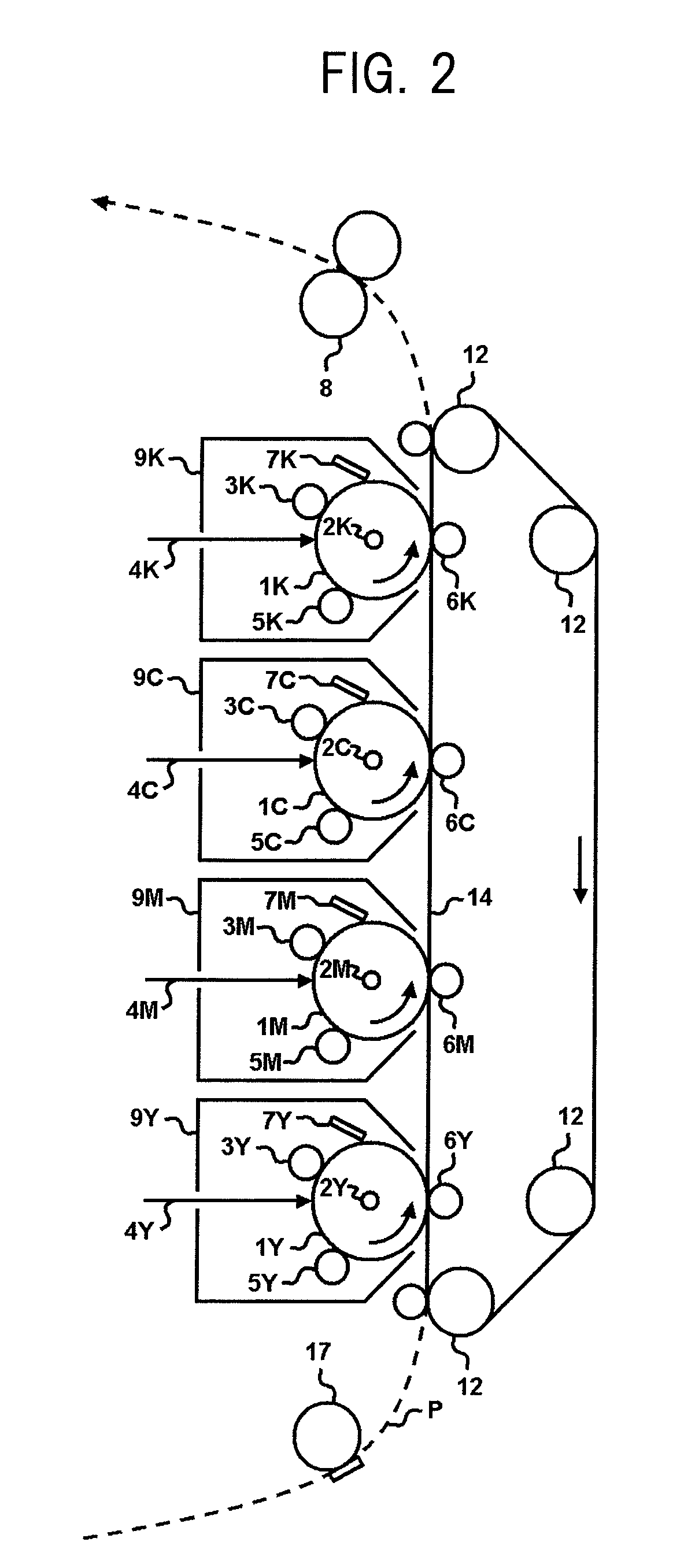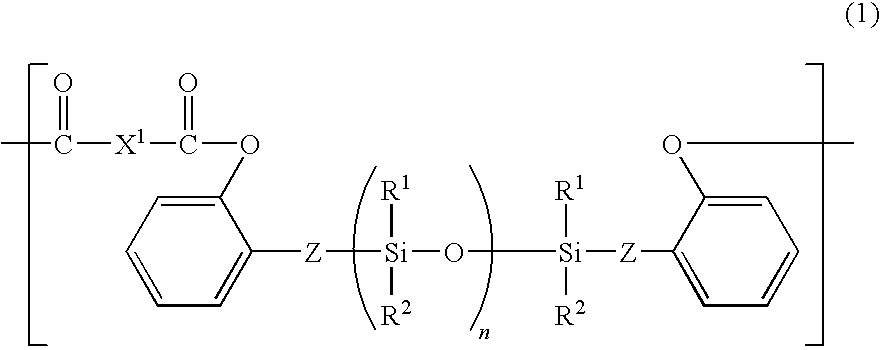Electrophotographic photosensitive member having siloxane-polyester, process cartridge and electrophotographic apparatus
a technology of photosensitive members and polycarbonate resins, which is applied in the direction of electrographic processes, instruments, and corona discharge, can solve the problems of insufficient order, insufficient mechanical strength of polycarbonate resins disclosed in patent documents 1 and 2, and inability to meet the requirements of electrophotographic functions, etc., to achieve excellent potential stability and mitigate contact stress
- Summary
- Abstract
- Description
- Claims
- Application Information
AI Technical Summary
Benefits of technology
Problems solved by technology
Method used
Image
Examples
synthesis example 1
Synthesis of Polyester Resin A (A1) Having Repeating Structural Units Represented by the Above Formulas (1-6), (1-12), (2-12) and (2-24)
[0142]Dicarboxylic acid halide (24.6 g) represented by the following formula (6-1):
[0143]
and dicarboxylic acid halide (24.6 g) represented by the following formula (6-2):
[0144]
were dissolved in dichloromethane to prepare an acid halide solution.
[0145]Furthermore, separately from the acid halide solution, a diol (21.7 g) having a siloxane structure represented by the following formula (7-1):
[0146]
and a diol (43.9 g) represented by the following formula (8-1):
[0147]
were dissolved in a 10% aqueous sodium hydroxide solution. Furthermore, tributylbenzyl ammonium chloride was added as a polymerization catalyst and stirred to prepare a diol compound solution.
[0148]Next, the above acid halide solution was added to the above diol compound solution while stirring to initiate polymerization. The polymerization was performed for 3 hours with stirring while the ...
synthesis examples 2 to 7
Synthesis of Polyester Resins A (A2 to A7) Having Repeating Structural Units Represented by the Above Formulas (1-6), (1-12), (2-12) and (2-24)
[0151]Use amounts of dicarboxylic acid halides (6-1) and (6-2) and the diol compounds (7-1) and (8-1) used in Synthesis Example 1 in synthesizing were controlled to synthesize polyester resins A (A2 to A7) shown in Table 1.
[0152]Furthermore, the contents of the siloxane moieties in polyester resins A (A2 to A7) were calculated in the same manner as in Synthesis Example 1 and shown in Table 1.
[0153]Furthermore, the weight average molecular weights of the polyester resins A (A2 to A7) were measured in the same manner as in Synthesis Example 1. The weight average molecular weights were respectively:
polyester resin A (A2): 120,000
polyester resin A (A3): 100,000
polyester resin A (A4): 80,000
polyester resin A (A5): 130,000
polyester resin A (A6): 150,000
polyester resin A (A7): 160,000.
synthesis example 8
Synthesis of Polyester Resin A (B1) Having Repeating Structural Units Represented by the Above Formulas (1-7), (1-13), (2-12) and (2-24)
[0154]Dicarboxylic acid halide (24.4 g) represented by the above formula (6-1) and dicarboxylic acid halide (24.4 g) represented by the above formula (6-2) were dissolved in dichloromethane to prepare an acid halide solution.
[0155]Furthermore, separately from the acid halide solution, using diol (21.0 g) having the siloxane structure represented by the following formula (7-2):
[0156]
and diol (44.2 g) represented by the above formula (8-1), the same operation as in Synthesis Example 1 was performed to obtain polyester resin A (B1) (70 g) having repeating structural units represented by, the above formulas (1-7), (1-13), (2-12) and (2-24). This is shown in Table 1.
[0157]Furthermore, the content of the siloxane moiety of polyester resin A (B1) was calculated in the same manner as in Synthesis Example 1 and shown in Table 1.
[0158]Furthermore, the weight ...
PUM
 Login to View More
Login to View More Abstract
Description
Claims
Application Information
 Login to View More
Login to View More - R&D
- Intellectual Property
- Life Sciences
- Materials
- Tech Scout
- Unparalleled Data Quality
- Higher Quality Content
- 60% Fewer Hallucinations
Browse by: Latest US Patents, China's latest patents, Technical Efficacy Thesaurus, Application Domain, Technology Topic, Popular Technical Reports.
© 2025 PatSnap. All rights reserved.Legal|Privacy policy|Modern Slavery Act Transparency Statement|Sitemap|About US| Contact US: help@patsnap.com



